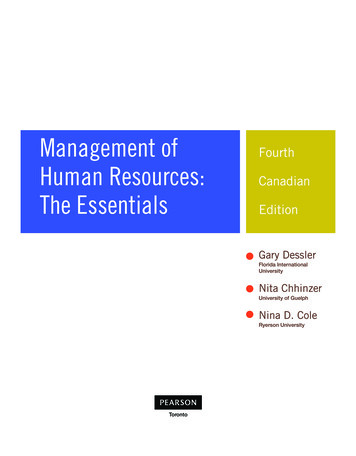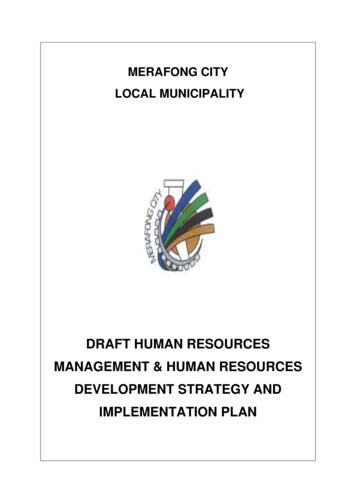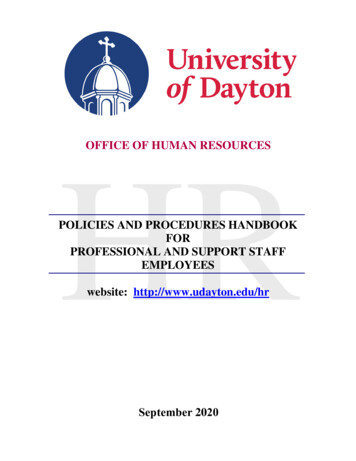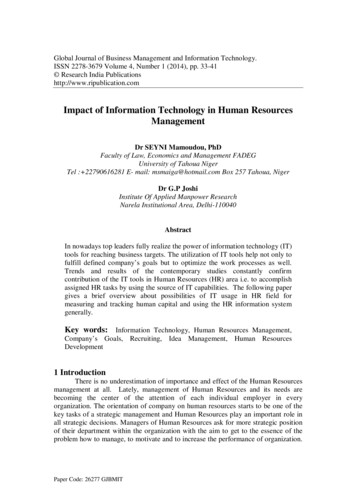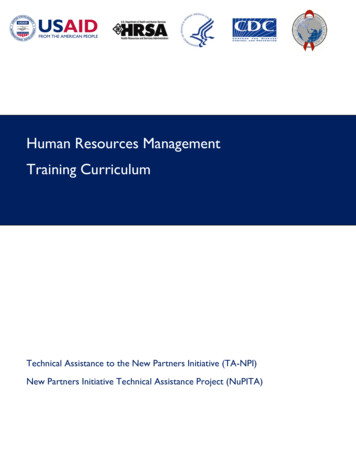
Transcription
International Journal of Business and Social ScienceVol. 7, No. 2; February 2016The Application of Human Resources Management in Multi-National CompaniesDr. Panteha FarmaneshBusiness ManagementKaraoglanoglu CampusGirne American UniversityGirneNorthern Cyprus.AbstractStaffing management of multinational companies is a complex but crucial issue to the international humanresource management (IHRM) research. Based on literature review, this article is to investigate the staffingmanagement in multinational companies. Firstly, the author will summarize the conceptual introduction, generalchallenges, culture distance, and new alternative in the expatriate assignments. Secondly, the author will discusshow to retain subsidiary staff retention in the whole HRM of multinationals. Thirdly, in order to complete theresearch successfully, the author will utilize the qualitative research method through literature study and one-toone interview to figure out the puzzle about the staffing management in multinational and draw the conclusion.IntroductionThe topic of this paper is staffing management in the multinational companies by using qualitative researchmethod. In this report, what kind of information is valued for this research? How to collect information? Whatkind of technology will be used and how to organize this research? All these questions will be described in thefollowing parts.First of all, the clear understanding about qualitative research is necessary and helpful. Qualitative research is afield of inquiry that crosscuts disciplines and subject matters. It involves an in-depth understanding of humanbehavior and the reasons that govern human behavior. Unlike quantitative research, qualitative research relies onreasons behind various aspects of behavior.ObjectiveThe objective of this article is to investigate staffing management in the multinational companies. In the lastdecades, an extensive amount of articles on this topic have been published. Obviously, the staffing managementis a critical issue in the human resource management for the multinational companies. How to balance the PCNs,HCNs, and TCNs? How to reconcile the individual career plan to the corporation scope? How to manage themulticultural team? All of these topics have been explored in conceptual theory and empirical analyses. At thesame time, with the development of the world economic and political, some new trends have appeared ininternational business, for example, global virtual team, the e-business, etc. These new challenges bring newpatterns for staffing management. Thus, in this article, the author focuses on new changes, such as alternative forthe conventional expatriate assignments and the retaining of the local staff retention.Literature ReviewIn order to get the general knowledge about staffing management in the multinational companies, six books havebeen chosen as the literature related to the topic. In those books, the authors claimed that people are thefoundation in a multinationals; most of the attention of human resource management in multinationals isconcerned with staffing management, while the staffing management is the most difficult task for them. How toeffectively manage people in various countries and cultures is a big issue in staffing management in themultinational companies.191
ISSN 2219-1933 (Print), 2219-6021 (Online) Center for Promoting Ideas, USAwww.ijbssnet.comAt the same time, in order to get the recent research topic in the multinational staffing management, some articleswhich were published in the academic journals have been chosen as well.1. Conceptual IntroductionStaffing management deals with a comprehensive term for all operative functions namely recruiting, placing,appraisal, rewarding, assessing, developing performed in HR management. According to International HRMmodel created by Patrick V. Morgan and Peter J. Bottrall, three dimensions are involved:Human resource functionsProcurementAllocationUtilizationNational or country functionsThe host country where a subsidiary may be locatedThe home country where an international company is headquartered“Other” countries that may be the source of labor or financeEmployees functionsLocal/ host-country nationals (HCNS) Expatriates/parent-country nationals (PCNS) Third-country nationals (TCNS)Faced with those options and wide resource, the managers in global enterprises have particular concern about theemployees’ ability to disseminate knowledge and innovation throughout their global operations. The use ofexpatriates has seemed to be a logical choice for staffing, while the use of parent-country nations seems to bemost appropriate in some specific situations. Some other global enterprises also prefer to integrate the expatriatesand local human resource. Nevertheless, each procedure has both advantages and disadvantages.With regard to executive nationality staffing policies, “There are four major categories on the HRM withinMultinational corporations: the ethnocentric approach, the polycentric approach, the region-centric approach, andthe geocentric approach.In summary, those four approaches are useful for multinationals and the MNC can choose one of four approachesto manage its international staffing. However, there are no restricting rules for staffing management. Thefollowing questions for the multinationals must be faced: Predictors of expatriate success, expatriate failure rate,repatriation, equal employment opportunity issues, and recruitment and selection of HCNs and TCNs.2. Challenges in multinationalsThe nature of international business is undergoing a sea of change. The rapid expansion of global trade, businessconsolidation and geographical diversification are pushing companies for changes in their management structureand style. Multinationals now need to consider regional market conditions and develop strategies to cater to eachof the regional markets.Another factor driving the need for change is the global mergers and acquisitions. Companies acquire othercompanies’ abroad need to change their HR policies as it is not applicable on the acquired company. It isbeneficial to invite top executives of the acquired firm to join the parent's top management.2.1 Career blockageLots of employees will be excited to have the opportunity to work abroad. In fact, for host-country manager whoalways have limited opportunities to gain experience outside their own country and cannot progress beyond thesenior positions in their own subsidiary. While, the parent-country manager has limitations too and they will feelfrustrated when they come back home to see their colleagues are promoted and their career have been sidetracked.2.2 Culture shockCulture shock is the big challenge for multinationals, the difference brings the different ways of thinking andworking methods and it needs time to adjust to it. In most cases the expatriate manager prefers to emphasize andrequire the home office or home country values on the host country’s employees instead of accepting and learningwithin the new culture.192
International Journal of Business and Social ScienceVol. 7, No. 2; February 20162.3 Lack of cross cultural trainingIn fact, most multinationals ignore this training program durin staffing management. However, the betterunderstanding about culture block can help managers to improve the effectiveness of staffing management. Forexample, the managers at Bell, Canada were asked specifically for training on Muslim laws of drinking and thetreating of women there, before he or she assigned a project for Saudi Arabia such as constructing the telephonesystem there.2.4 Family problemsFamily problems for PNC manager is another challenge. The oversea employees always think of their family.Sometimes, such emotion will affect the concentration at their work. These difficulties are usuallyunderestimated. What the organization should do is to assist expatriates’ family to adapt their new environment.3. Managing multicultural teamTeam members of multinational companies come from different countries with a different culture, economic,religions and habits. All of these differences bring a different thinking and working methods, thus, how to managethe multicultural team is a big challenge for the HRM in the multinationals. In the article “Managing multiculturalteam”, the author states that “Communication in Western cultures is typically direct and explicit. In many othercultures, meaning is embedded in the way the message is presented. The differences can cause serious damage toteam relationships” (Jeanne Breeet , Kristin Behfar, and Mary C. Kern, 2007). At the same time, the accent andthe lack of fluent communication will affect the understanding and the integration between team numbers. Thedirect effect of misunderstanding can also be the barrier to constrain the team achieving the projects’ commongoal. Therefore, the scholar indicates the following four strategies as to how to manage a multicultural team(Jeanne Breeet, Kristin Behfar, and Mary C. Kern, 2007):Adaptation: acknowledging cultural gaps openly and working around teamStructural intervention: changing the shape of the teamManagerial intervention: setting norms early or bringing in a higher-level managerExit: removing a team member when other options have failedAlthough those four strategies can be used to deal with some challenges in the multicultural team, the first step tomanage the multicultural team for team managers is to identify what kind of challenge the team would face.Sometimes, we can advocate the post-modern thinking as a popular but unofficial thinking which can be usedamong the team numbers. We try to understand and think about questions from the other side without prejudice.However, the official team management needs some norms and rules to keep the right orientation. In my opinion,when facing the team troubles, we should see the troubles from the culture angle, through the social thinking waysinstead of from the personality.4. New Alternative in the Expatriate AssignmentsAccording to Edstorm and Galbraith (1977), there are three motives why MNCs use expatriates.As position fillers when suitably qualified host country nationals (HCNs) were not available.As a means of management development, aimed at developing the competence of the individual manager.As a means of organizational development, aimed at increasing knowledge transfer within the MNC andmodifying and sustaining organizational structure and decision processes.However, the high cost and the family problems are the evident shortcomings of the conventional expatriateassignments. Recently, more and more research begins to question the utility and viability of the conventionalexpatriate assignments. According to the “Changing patterns of global staffing in the multinational enterprise:challenges to the conventional expatriate assignment and emerging alternatives” (David G. Collings, HughScullion and Michael J. Morley, 2007), there are five aspects related to the debates: supply side issues, demandside issues, expatriate performance and expatriate “failure”, performance evaluation, cost and finally careerdynamics. By reviewing the reasons of those challenges, the authors explore some alternative forms in theinternational assignments now:Short–term international assignmentsFrequent flyer assignmentsCommuter and rotational assignments193
ISSN 2219-1933 (Print), 2219-6021 (Online) Center for Promoting Ideas, USAwww.ijbssnet.comGlobal virtual teamThe HR implications of managing alternative forms of international assignmentsAlthough those new patterns appeared in the international staging assignments, each alternative has both positiveand negative influences. For example, as scholars mentioned that the short-term assignments are the most popularform of non-standard assignment. At the same time, they also identify the following situations in which shortterm assignments are used in MNCs: (1) Problem solving or skills transfer; (2) for control purposes and; (3) formanagerial development reasons. And the disadvantages: (1) taxation issues particularly for assignments over sixmonths duration, (2) the potential for side-effects such as alcoholism and marital problems (3) failure to buildeffective relationships with local colleagues and customers and (4) work visas and permits (Tahvanainen et al.,2005) . Eventually, the challenge for IHRM practitioners is to ensure that each international assignment hasclearly defined goals and in this context to continue the advancement of techniques aimed at measuring the returnof investment on international assignments.5. Retaining Subsidiary Staff’s RetentionIt can be argued that the retention of staffing in the multinationals’ subsidiary conducts huge influence. Thetransfers between the PCNs, HCNs and the TCNs are the big issues in the staffing management strategy. Scoldersidentify that the HCNs and TCNs who are sent to the corporate headquarters (HQ) called in-patriates. As thisarticle mentioned before, the ethnocentric approach, the polycentric approach, the region-centric approach, andthe geocentric approach are the four major nationality staffing policies in the international staffing, by analyzingthe complex and the new situations appear in the relationships between the HQ and subsidiary, B. SebastianReiche (2007) explores the international staffing-related retention strategies. Firstly, he claims that a pluralisticand consensus-driven approach to international staffing enhances the retention capacity of international staffingpractices, through increased responsiveness to and the involvement of the respective local unit. He states that theknowledge and skill from the local staff can help multinationals to reduce the risk and culture-bound in the localmarket. He also believes that this approach can improve the loyalty of local staffs, and the local staff can achieveindividual career plan to cohere the institutional development plan. At the same time, he states that the PCNs stillact as the vital role for informal controlling and coordination in the multinational companies. Secondly, heindicates that expatriation of local staff can help to retain the MNCs’s retention. In this approach, he states that the“impetrates can share their social and contextual knowledge of the subsidiary environment with managers at theHQ. And also impetrates tend to be accepted by HCNs more willingly than foreign personnel.”According to the literature review, we can see that staffing management is the big and critical issue in themultinational human resource management. Although some models and some rules can be used in the staffingmanagement in multinationals, there is no magic formula which we can follow, and there is no silver bullet thatgives the kill. Simultaneously, I also find some challenges and some new patterns of staffing management inmultinationals, in order to get a better understanding about the staffing management strategy in multinationals,and to prove some confused questions in my mind, like why are there so few women on internationalassignments? The designed qualitative research which addresses staffing management in multinational companieswill be presented as the following:MethodologyA successful qualitative research should have the clear introduction about the research methods, the detailed andscientific research, and the justice and related data analysis. In this part, how to develop and execute thisqualitative research will be described:1. Research methodsResearch methods are the tools to be used in this qualitative research. It is the basic elements to do the research,and the better and clear understanding is helpful and necessary for the success of the research. In the followingpart, I will introduce some research methods which will be used in this qualitative research.In-depth interview: are typically used in survey development. One-to-one interviews are conducted (with peoplemeeting the criteria for completing a particular survey) when individuals complete the instrument. This methodhelps investigators understand how people perceive and interpret language and their own experiences as theyrefine the survey instruments.194
International Journal of Business and Social ScienceVol. 7, No. 2; February 2016Five persons (individual profiles as the following table) will be interviewed to talk about this project. Thequestions sheet was designed for the interview. The purpose of the interviews is to figure out the strategic aboutthe staffing management in the multinational companies, especially the challenges in the multinational is themajor issues in the interview.Interviewees AgeGenderBackgroundWorking experienceA36MalePHD Electric Engineer7 years EngineerB33MaleMaster engineer& MPM5 years HR managerC32MaleMaster MPM4 years marketing managerD29FemaleMaster MBA2 year HRE25FemaleMaster MBA1 year HR2. Research ProcedureIn this research, the five persons who have the background with working in the multinational companies or whohave the academic ideas about the human management will be involved in this research. This research has twoparts, the first part will discuss about the important position for staffing management in one multinationalcompany. The second part is about the challenges, and tries to find the solutions for those challenges.3. Data collection and analyzingIn this stage, enough and useful data is necessary for qualitative research. Collecting data is the key step toachieve the research goal after in-depth interview and case study.Based on the four challenges about the human resource management in the multinational companies, through thein-depth interview with five persons and the case studies, the result about this research is to find the way how tosolve those challenges.4. Research ScheduleAll the research development will follow the deliverables on the course outline.Proposal: Deadline is February 20Interview protocol: Deadline is March 12Interview: Deadline is April 10Oral presentation: Deadline is April 16Research report: Deadline is April 285. Interview5.1 Interview planTraditionally, the detailed plan is the first step for a successful interview. For me, the major thing should bedescribed is about the interview tools. The in-depth interviews are typically used in this interview. One-to-oneinterviews are conducted as the individuals complete the instrument being tested. This method helps investigatorsunderstand how people perceive and interpret language and their own experiences as they refine the surveyinstruments. At the same time, based on the topic which is staffing management in the multinational companies, Iwill choice the telephone interview too.Five persons will be interviewed to talk about this topic. The purpose of the interviews is to figure out the strategyabout staffing management in the multinational companies, especially the challenges in the multinational is themajor issues in the interview. Three persons are chosen from the classmates who had or have the workingexperience in the multinational companies, the fourth person is my friend who works in a multinational companyin Toronto, and I will meet him in the weekend to do the interview. The last person works in Montreal, and I willtake a telephone interview.5.2 Level of LanguageThe effective communication is the critical issue for the success of the interview. A better understanding ishelpful to achieve the purpose of the interview.5.3 Interview questions1.Do you think the staffing management is a critical issue for multinational companies?2.Do you think staffing issues are different and complex in the multinational companies?195
ISSN 2219-1933 (Print), 2219-6021 (Online) Center for Promoting Ideas, USAwww.ijbssnet.com3.Should there be different strategy between the employees in local/ host-country nationals(HCNS) expatriates/parent-country nationals (PCNS), and third-country nationals (TCNS)?4.How to motive expatriate employees?5.How to make justice between local and expatriate employees?6.How to implement performance management for the host-country nationals?7.How to manage diversity management?8.Why are there so few women on international assignments?9.What kind of training is necessary for the international assignees?10.What are the challenges about staffing management in multinational companies?5.4Analyses about the interview questionsAs I mentioned before, five persons were to be interviewed to talk about this topic. Three persons are chosen fromthe classmates who had or have the working experience in the multinational companies, one person who works inthe AMD in Toronto, I was meeting him last weekend. And another person who works in Montreal, I alreadycalled him to do the telephone interview. Those entire people have the common thinking which is staffingmanagement is very importance and diversity in multinationals. The detailed analysis about the interviewquestions as following.1. Do you think staffing management is a critical issue for multinational companies?The same answers from five interviewees.All of them given yes to this question.Analysis: People are one of the most important parts in multinational companies. The staff are from differentcountries, they have diverse cultures, religions, and working styles. Therefore, the working environment can bevery complex. Finding skilled and talented personnel and motivating them then becomes more and moreimportant. How to resolve problems and conflicts, and integrate the diverse human resource and management isgoing to be a critical issue.2. Do you think staffing issues are different and complex in the multinational companies?All of five interviewees answered yes in this question.Analysis: Compared to the national company, the multinational company’s target market may be numerouscountry or while world. According this situation, the employees of multinational companies have differentculture, religion and life habit. The employees’ diversiform culture background can help the multinationalcompany understand the local market environment; however, it increases the cost of staffing management. Themultinational companies should pay more an attention on the HR management. The enormous human resourcedata and complex work environment is a trouble for the multinational companies. At the same time,communication problem is also critical when people speak different languages.3. Should there different strategic between the employees in local/ host-country nationals (HCNS),expatriates/parent-country nationals (PCNS), and third-country nationals (TCNS)?The answer is yes.Analysis: Based on the countries’ different conditions like economic, living standard, market, etc. The local,expatriates and third-country nationals’ employees are in the different positions. The HCNS are familiar with theculture, environment, and the communication habit. Therefore, the management strategy can be very simple andeasy. However, for the PCNS and TCNS, they are unacquainted with the country, and it is harder to accommodatethemselves with the new living and working environment. So the communication process will be more complex.Consequently, the companies should use different strategies between the different nationals’ employees.4. How to motive the expatriate employees?In this question, building own company culture which is not only local culture but also expatriate and recognizingthe and respecting the different culture and habits has been mentioned in all five interviewees. As interviewees Cstates that familiarizes the new employee to the company’s culture, business values, people, organization andprocesses in an efficient manner. Then, helping the person fit into their new environment, lowers feeling ofisolation and anxiety, and increases feelings of comfort, security and belonging. Also, creates a favorableimpression and attitude.196
International Journal of Business and Social ScienceVol. 7, No. 2; February 2016At the same time, interviewee D thought that Special benefits and holidays are the necessary and important rulesto motives the expatriate employees.5. How to make justice between local and expatriate employees?The answers about this question related to the understanding about culture and habits and the performanceevaluation. Firstly, a series of regulations and rules should be created. Then, try to avoid bias, think objectively,and stand by different positions to see the view.At the same time, the performance evaluation should have the same standard.6. How to implement performance management for the host-country nationals?The performance management should be made based on the appraisals which provide legal and formalorganizational justification for employment decisions. Also, the appraisals are used as criteria in test validationand provide feedback to employees. Meanwhile, the appraisals can help establish objectives for training programsand determine organizational problems.7. How to manage diversity management?In this question, there are many answers: A, create chance to know each other; B, Equal opportunities is just onepart of diversity, detailed policies and procedures should be user-friendly; C, establish a heterogeneous workforceperforming to its’ potential in a fair work environment where no member has an advantage or disadvantage forany reason other than merit. D; Establish a training system to reduce failure and conflicts.Establish effective communication to exchange information in time.8. Why are there so few women on international assignments?In this question, there have different answers between the male and female interviewees; two male intervieweesstate that this situation is based on history, culture, like working capability of women can’t be accepted byeveryone. One male interviewee claims that he did not find this situation because one of the groups in hisdepartment is all women who are in charge of both local and international assignments. The two femaleinterviewees said that Women have more family and emotional burden, and women always lack of careerprogress (glass ceiling).9. What kinds of training are necessary for the international assignees?In this question, most interviewees mentioned that the international assignees should be trained in the knowledgeof culture, religion, value and working style. Interviewee B still talked about the training should be connectedwith Sexual Harassment, Legal Issues and Global Corporate Finance.10. What are the challenges about staffing management in the multinational companies?A Touch different thinking approach and cultureB How to Improve Expatriate-Local RelationsC How to respect the diverse values, and establish the same corporation values is most challengeD Conflicts between cultures, communication problems, performance standard.E Unions want to cooperate but compete with each other for jobsFindings and ResultsThe interviews proved my viewpoint that the staffing management is critical and complex to a multinational.Therefore, to successfully achieve its goal, the multinational not only insist its successful experience and culturebut also should adjust the strategy due to the diversity and complexity of human resource management whichincludes the staffing management strategy. In my research, I focus on two aspects: first is about the importance ofstaffing management in multinational, which even should be considered as the most crucial part in multinationalslife. My interviews have proven my standpoint, all interviewees agree on the importance of staffing management.A mistake the multinationals may make is they believe the successful experience in the home country will workwell in other parts of the world. But the fact usually says no. Therefore, the multinationals need to learn how toface the “difference” in different thinking ways, policy, culture and people’s desires. Thus, the second aspect ishow to make and implement the proper staffing management due to de complexity and difference of countrysituation.197
ISSN 2219-1933 (Print), 2219-6021 (Online) Center for Promoting Ideas, USAwww.ijbssnet.comBased on this understanding, I listed my questions like “How to motive expatriate employees”, “How to managediversity management?” and “What kinds of training are necessary for international assignees”. Most of thesequestions relate to the people. Undoubtedly, people are the most important factor in all aspects. No matter howcorrect a decision or strategy has been made, it depends on how people implement it. My interviewees answeredthe questions through different aspects which base on their experience. Clearly, all of the answers based on onecommon point that the staffing strategy has to meet peoples’ basic demands, culture, and inspire them properly.Above all, the interviews supported my original viewpoint and extended my visions in several aspects which Ilearned from the literatures. I will give the conclusion in next part.ConclusionIn the past ten years many business cases proved that human resource management especially the staffingmanagement is the critical factor for a successful business. Based on the analysis about the interviews, I got someconclusion. Firstly, staffing management is the critical issue for the multinational has been proved. People are oneof the most important parts within the company. People with different culture will cause a lot of problems becauseof culture differences for multinational companies. Because of globalization, businesses are not just addressedwithin a country, as it becomes global as well. So how to find, select and train skilled and talented personnel andmotivating employees then become more and more important. Secondly, the staffing management issues aredifferent and complex in the multinational. These issues still relate to the cultural understanding.Different people have different ways of thinking based on the individual background, and different nations havethe different habits due to history, religion, policy, etc. The
The Application of Human Resources Management in Multi-National Companies Dr. Panteha Farmanesh Business Management Karaoglanoglu Campus Girne American University Girne Northern Cyprus. Abstract Staffing management of multinational companies is a complex but crucial issue to the international human resource management (IHRM) research.



